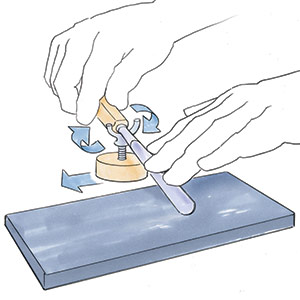The perfect carving knife
Amy Umbel argues fancy sloyd knives and expensive gouges are all well and good, but the perfect knife for any carver—especially a beginner—is the one you will actually use. Time, practice, and love for the craft are more important than any tool.
When people ask me to recommend tools, I usually disappoint them. I was asked recently to write about sloyd knives for Fine Woodworking and I immediately replied, “I don’t care about sloyd knives. I think people spend too much time fussing over finding the perfect knife and not enough time actually carving.”
Then, as usual, I backtracked partway and said, “I mean, it’s nice to have something that works well and is reliable. But I know fantastic carvers who started with utility knives.”
It’s not the knife that makes the carver.
As a kid I carved with a small Remington pocketknife that came in a big package of .22 ammunition. I carved a lot with that knife and it worked very well—in spite of my questionable sharpening prowess as a 10-year-old. I learned about wood grain with that knife, and about how to sharpen. It was exactly what I needed. As my skill grew, so did my knowledge of what was required in my tool arsenal.
When I started carving professionally, I did succumb to the idea that to get better I needed more expensive tools. At the time, I was fascinated by carving bowls; I still love that form. My first purchase was a Pfeil gouge (7/30, if anyone is curious) and I used it for everything including spoons. It worked well, but I was convinced that if I got a more expensive brand everything would somehow miraculously become better.
After waiting for months to get my Excalibur, I opened the box eagerly. But when I put it to use, I was disappointed that the handle was uncomfortable. And it had cost so much that I was afraid to sharpen it.
I sold it years later, barely used.
That excellent carver who started with a utility knife upgraded, of course—because if you start with a utility knife you learn quickly what works and what doesn’t and, more importantly, why it works or doesn’t. Going through the process of learning is invaluable. It’s the whole point of doing anything. You can skip steps, but if you do, you’re not doing yourself any favors.
When it comes to tools, I say start with what you have. You don’t need to spend hundreds of dollars on a knife to make good work. Fancy tools won’t improve your skill. Time, effort, and commitment are what make a good craftsperson. So when the question inevitably arises, I answer, “Don’t worry about the perfect knife. Love for your work and for the process is the best tool you could ever possess.”
—Amy Umbel is a carver, writer, and podcaster who travels the world to teach and learn about craft.






















Comments
There's a lot to be said in favour of learning by mistakes, including the mistake of trying to make various kinds of carving cuts with an edge not suitable for the task. But using a poorly edged tool to attempt something it can't do well enough (or at all) is still a mistake. it doesn't take more than a few minutes to realise that a poor tool either needs fettling or, more likely, replacing with one of more better tools that can perform the actions we want to perform.
Pocket knifes, in particular, are like many other modern inexpensive tools - made down to a price rather than up to a standard. There's an enormous amount of dross out there that can't really be fettled no matter how much time you spend on it.
So, after coming anew to green woodworking and carving, I would recommend avoiding the mistake of starting with a pocket knife, especially a cheap & nasty pocket knife. Any kind of carving takes more then one tool form, especially when the tool is a knife.
Good axes, gouges, knives of various blade shapes and so forth can all be bought for smaller rather than larger amounts. You don't have to spend thousands on the best Swedish must-haves. You don't even have to spend hundreds on medium level items like Flexcut.
For example, Beavercraft knives, gouges et al are inexpensive and very good quality for the price. A $50 kit (of which they have many) will at least have a knife or two configured for carving and perhaps also a gouge and the means to strop all of them to keep them as sharp as when new. There are other similar inexpensive but good quality tools in the market.
"Love for your work and progress" is certainly a necessary condition for getting good at something. But that's not sufficient. Tools made for the job are also needed. Tools made not-for-the-job seems a bit like whipping yourself for fun - only of use to masochists. :-)
Lataxe
Log in or create an account to post a comment.
Sign up Log in